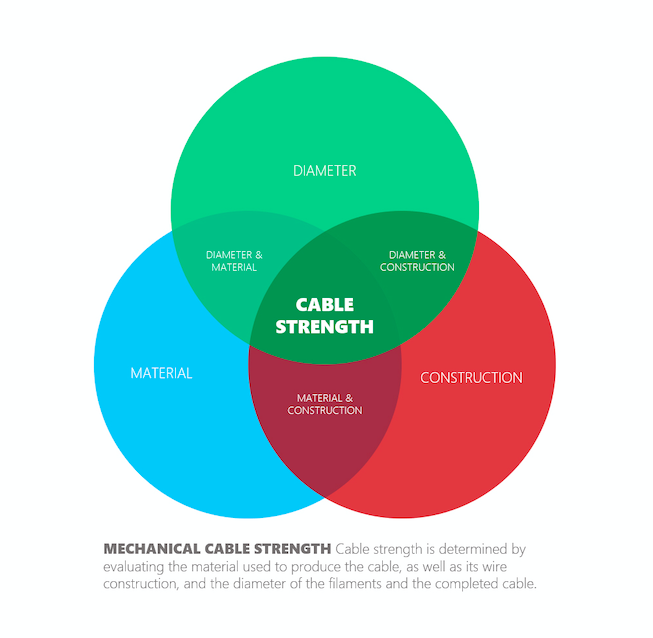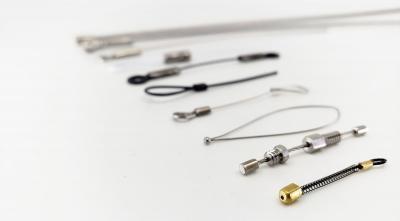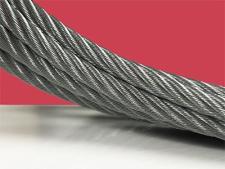What Is the Strongest Wire Rope?
Depending on the application, wire rope strength is determined on a case-by-case basis. 304 Stainless steel cable, for example, may not suit applications where excessive heat is present. Conversely, tungsten, the strong metal known on earth, will perform exceptionally well under extreme heat. Accordingly, the question isn’t necessarily, “what is the strongest wire rope?”, but rather, “what do you need to accomplish with mechanical cable?”
To determine the wire rope strength suited to the application, material, diameter and construction are variables engineers evaluate.
How Is Strength Measured With Wire Rope?
As discussed, mechanical engineers consider the material, diameter and the quantity of filaments that comprise the wire rope or miniature cable. So, these characteristics, taken in the aggregate, inform the choice of cable and its strength benefits.
Mechanical Cable Material
304 stainless steel is among the strongest, and most popular materials used in the manufacturing of mechanical cable. While other grades of stainless steel prevail in wire rope and miniature cable making, 304, in the USA in particular, is extremely common.
Stainless steel cable is used in virtually all markets that use mechanical cable to achieve motion. Whether in endoscopic medical instruments, or an air-defense system, or even an implantable hip joint system, stainless steel is a staple. However, tungsten mechanical cable, common in the growing surgical robotics space, has swiftly supplanted stainless steel as the go-to ultrafine cable material.
But the strongest cable material is again decided by the engineer’s application requirements.
Empirically, tungsten is the stronger material as compared with stainless steel alternatives. Pound for pound, tungsten, on the periodic table known as wolfram or simply W, is the strongest metal on earth. Thus, again speaking scientifically, it trumps stainless steel. But, for instance, in applications where tungsten properties aren’t as desirable, stainless steel will outperform the presumably stronger alloy. Say, the application is going to be implanted into a human’s hip joint. In this case, the non-corrosive properties of stainless steel, combined with its strength offering, makes it the ideal cable material for this surgical application. Furthermore, choosing stainless steel in this case promises a more cost-effective cable product because tungsten is dramatically more expensive.
However, if the tensile strength required of the application exceeds that of what stainless steel can yield, in a given diameter, say in the appendages of a surgical robot, tungsten is the stronger candidate. Tungsten will not compromise strength along tight turns, where miniature pulleys are required. But, if stainless steel were used to make tight radii, around extremely small pulleys, the material’s springiness may resist a given radius and perhaps compromise flexibility and subsequently lifecycle.

Mechanical Cable Diameter
When determining if the cable is strong enough for the application, the filament diameter, along with the cable’s overall outer diameter (OD), contribute as well.
All mechanical cables comprise stranded wires. The larger the diameter of these wires, contributes greatly to the tensile strength achieved. So, in simplest terms, a tungsten surgical robotics cable, made from 201 wires, but at a diameter of .0005”, would not possess the strength of the same cable made from .0007” wires.
And while the difference between a single 7 and a 5 appears marginal, the difference in strength - going from .0005” to .0007” is dramatic. What’s more, adding larger diameter wires, even in constructions with fewer total wires in the cable strand, may yield more strength that more wires, albeit smaller ones, in comparably sized cable. So a 1x7 cable, which comprises seven total wires, at an outer diameter (OD) of .016” will actually yield more tensile strength that a 3x3, which comprises nine total wires, at an OD of .017”.
Mechanical Cable Construction
When two, or even 10 cables, are made from the same alloy, say tungsten, for instance, the quantity of wires, the design of construction of the mechanical cable, as well as the diameter of completed strand, all coalesce to determine strength.
Counterintuitive as it seems, adding more tungsten wires to a miniature cable, for instance, constructed in extremely small diameters, does not necessarily yield the engineer a stronger cable. Because adding ultrafine tungsten wires also adds flexibility to the completed cable, the engineer may accept some strength limitations in favor of significant improvement in malleability. While this is not always so, adding larger, but fewers filaments, provides the engineer a more rigid cable, but one more flexible around tight radii.
Strength of the mechanical cable, as is likely becoming clearer, is therefore not entirely determined by the size of the wires, nor the wire material, but the total sum of these and other variables.
The Correlation Between Strength and Longevity
When determining how much weight your mechanical cable can handle, engineers recommend using approximately 60 percent of the cable’s breaking strength. If the mechanical cable breaking strength is 100 pounds, for example, engineers would only use the cable to support 60 lbs. The higher the rated strength of the cable, the more force engineers can apply to it.
At Carl Stahl Sava Industries, we want to help you with your cable needs. Contact us today for more information.







